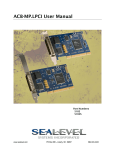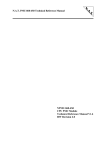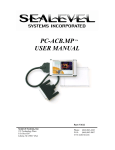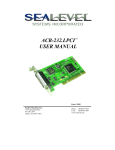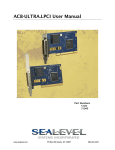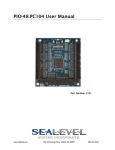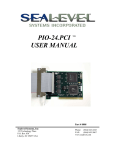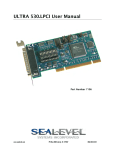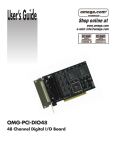Download SeaLevel ULTRA 530.LPCI User manual
Transcript
ACB-MP+4.PCI User Manual Part Number 5402 www.sealevel.com PO Box 830 – Liberty, SC 29657 864.843.4343 Table of Contents INTRODUCTION......................................................................................................................... 1 OTHER SEALEVEL SYNC PRODUCTS ............................................................................................. 1 BEFORE YOU GET STARTED ................................................................................................. 2 WHAT’S INCLUDED ...................................................................................................................... 2 OPTIONAL ITEMS.......................................................................................................................... 2 INSTALLATION & CONFIGURATION.................................................................................. 3 SOFTWARE INSTALLATION ........................................................................................................... 3 PHYSICAL INSTALLATION ............................................................................................................ 4 TECHNICAL DESCRIPTION.................................................................................................... 5 INTERNAL BAUD RATE GENERATOR ............................................................................................ 5 CONTROL AND STATUS REGISTERS DEFINITION........................................................................... 5 100-PIN CONNECTOR PIN OUT ..................................................................................................... 6 INTERFACE SELECTION ................................................................................................................ 7 DB-25M CONNECTOR PIN OUTS ................................................................................................. 7 ELECTRICAL CHARACTERISTICS .................................................................................... 10 FEATURES .................................................................................................................................. 10 SPECIFICATIONS ......................................................................................................................... 10 APPENDIX A – TROUBLESHOOTING................................................................................. 11 APPENDIX B - HOW TO GET ASSISTANCE ...................................................................... 12 APPENDIX C – ELECTRICAL INTERFACE ....................................................................... 13 APPENDIX D – SILK SCREEN – 5402 PCB .......................................................................... 15 APPENDIX E - COMPLIANCE NOTICES ............................................................................ 16 FEDERAL COMMUNICATIONS COMMISSION STATEMENT ........................................................... 16 WARRANTY............................................................................................................................... 17 © Sealevel Systems, Inc. SL9047 Revision 7/2009 ACB-MP+4.PCI User Manual Introduction The ACB-MP+4.PCI (Item# 5402) is a four-port PCI bus RS-232, RS-422, RS-485 synchronous serial interface. Designed using the popular Zilog Z85230 Enhanced Serial Communication Controller (ESCC), the board is an ideal solution for military, satellite, radar, banking, and other applications that require robust synchronous communications. For maximum flexibility, each of the serial ports can be individually configured for RS-232, RS-422, or RS-485 communications. In RS-232 mode, all common modem control signals are implemented for compatibility with a wide range of peripherals. A digital phase lock loop (DPLL) is included on each port, and the board supports data rates up to 128K bps in burst mode. For easy implementation, a fan-out cable is included that terminates the onboard 100-pin connector to four DB-25M connectors. The ACB-MP+4.PCI features Universal Bus (3.3V and 5V) compatibility with both new and legacy computer systems. Software support, critical for successful synchronous communication development, is provided through Sealevel’s SeaMAC V4 driver. HDLC/SDLC protocols are supported as well as certain configurations of Monosync, Bi-sync, and Raw modes. The ACB-MP+4.PCI also utilizes the Sipex-505 multi-protocol electrical interface chip that allows the ACB-MP+4.PCI to be compliant with EIA/TIA-530/530A, EIA/TIA-232E, EIA/TIA-485, and ITU V.35. Optional cables are available to connect RS-449, RS-530, RS-530A, V.35 and X.21 interfaces. Other Sealevel Sync Products PCI – 1-Port Route 56.PCI (P/N 5101) - Z16C32 RS-232/422/485/530/530a/V.35 ACB-MP.PCI (P/N 5102) - Z85230 RS-232/422/485/530/530a/V.35 Low Profile PCI – 1-Port ACB-232.LPCI (P/N 5103) - Z85230 RS-232 ACB-Ultra.LPCI (P/N 5104) - Z16C32 RS-232/422/485/530/530a/V.35 PC/104 – 1-Port ACB-104 (P/N 3512) - Z85230 RS-232/422/485/530/530a/V.35 ACB-104.ULTRA (P/N 3514) - Z16C32 RS-232/422/485/530/530a/V.35 PCMCIA – 1-Port PC-ACB-MP (P/N 3612) - Z85233 RS-232/422/485/530/530a/V.35 © Sealevel Systems, Inc. -1- ACB-MP+4.PCI User Manual Before You Get Started What’s Included The ACB-MP+4.PCI is shipped with the following items. If any of these items is missing or damaged please contact Sealevel for replacement. Item# 5402 – ACB-MP+4.PCI Adapter Item# CA339 – 100-Pin to (4) DB25M Breakout Cable, 36” in Length Item# SSI-CD – Sealevel Software CD with SeaMAC drivers Optional Items Depending upon your application, you are likely to find one or more of the following items useful for interfacing the ACB-MP+4.PCI to real-world signals. All items can be purchased from our website (http://www.sealevel.com) or by calling 864-8434343. CA104 – A 6’ serial extension cable with one DB-25 female connector and one DB-25 male connector, pinned one-to-one. CA107 – a 10” shielded cabling adapter with a DB-25F (RS-530) to a DB-37M (RS-449 DTE). RS-530 is replacing RS-449 in Telecom applications, but there is still a very large installed base of equipment that still uses the RS-449 pin-out. Both standards use RS-422 to define the electrical specifications and are interchangeable via this adapter cable. CA159 – A 6’ shielded cable with a DB-25 female connector (RS-530 pin out) to a DB-15 male connector (X.21 pin out) that converts the standard DB-25 implementation of RS-530 or RS-422 to the ITU-T X.21 standard. CA174 – A 6’ serial extension cable with twisted data pairs for increased data integrity. Recommended for high-speed RS-530 connections. CA178 – A 6’ shielded cable with a DB-25 female connector to an ITU-T ISO2593 style connector (V.35) that converts the Sealevel DB-25 implementation to the ITU-T V.35 mechanical standard. © Sealevel Systems, Inc. -2- ACB-MP+4.PCI User Manual Installation & Configuration Software Installation Windows 2000/XP/Vista™ Operating Systems Do not install the adapter until the software has been successfully installed.. Note: SeaMAC V4 is only supported under 32-bit versions of Windows 2000, XP, and Vista operating systems. 1. Start Windows. 2. Insert the Sealevel Systems CD in your CD drive. 3. If ‘Auto-Start’ is enabled for this drive the software will automatically launch. Otherwise launch the ‘autorun.exe’ file located in the root directory of the CD. 4. Click the ‘Install’ button. 5. Type in or select the part number for the adapter from the listing. 6. The setup files will automatically detect the operating environment and install the proper components. Follow the information presented on the screens that follow. 7. IN Windows XP, a screen may appear with the declaration: “The publisher cannot be determined due to the problems below: Authenticode signature not found.” Please click the ‘Yes’ button and proceed with the installation. This declaration simply means that the operating system is not aware of the driver being loaded. It will not cause any harm to your system. 8. During setup, the user may specify installation directories and other preferred configurations. This program also adds entries to the system registry that are necessary for specifying the operating parameters for each driver. An uninstall option is also included to remove all registry/INI file entries from the system. 9. The software is now installed and you can proceed with the hardware installation. © Sealevel Systems, Inc. -3- ACB-MP+4.PCI User Manual Physical Installation The adapter is universal bus compatible and can be installed in any 3.3V or 5V PCI expansion slot. Do not install the adapter until the software has been successfully installed.. 1. Turn off power. Disconnect the power cord. 2. Remove the PC case cover. 3. Locate an available PCI slot and remove the blank metal slot cover. 4. Gently insert the PCI adapter into the slot. Make sure the adapter is seated properly. 5. Replace the screw (required for FCC Part 15 compliance). 6. Replace the cover. 7. Connect the power cord and power up the machine. The ACB-MP+4.PCI is now ready for use. © Sealevel Systems, Inc. -4- ACB-MP+4.PCI User Manual Technical Description The ACB-MP+4.PCI utilizes the Zilog 85230 Enhanced Serial Communications Controller (ESCC) and includes a dedicated Z85230 per port. This chip features programmable baud rate, data format and interrupt control. Refer to the ESCC Users Manual, available from Zilog, for details on programming the 85230 ESCC chip. Internal Baud Rate Generator The baud rate of the ESCC is programmed under software control. The standard oscillator supplied with the board is 7.3728 MHz. However, other oscillator values can be substituted to achieve different baud rates. Control and Status Registers Definition The control and status registers occupy 12 consecutive I/O locations. The following tables provide a functional description of the bit positions. X = do not care. Base +4 +5 +5 +6 +6 +7 +14 +15 Mode RD RD WR RD WR RD RD RD D7 0 485CLK 485CLK 0 X X SD7 SD15 D6 IRQST ECHOA ECHOA 0 X X SD6 SD14 D5 0 SYNCA_RTS SYNCA_RTS 0 X X SD5 SD13 D4 0 SYNCA_CTS SYNCA_CTS 0 X X SD4 SD12 D3 0 AM3 AM3 RLA RLA IRQST4 SD3 SD11 D2 0 AM2 AM2 LLA LLA IRQST3 SD2 SD10 Field IRQST DSRA LLA RLA TSETSLA RXCOPTA SCC interrupt status: DSRA: Local Loopback: Remote Loopback: TSET clock source: RXCOPTA: Description 1 = No interrupt pending on ESCC 1 = DSRA not active 1 = LL set 1 = RL set 1= Received TXC as source 1= Selects SCC PCLK for RTXCA SYNCA_RTS SYNCA_CTS 485CLK ECHOA AM0 – AM3 SD0 – SD15 SYNCA _RTS: 1 = SYNCA connected to RTS SYNCA_CTS: 1 = SYNCA connected to CTS TSET switches with TXD: 1 = clk switches ECHO enable: 1 = echo disabled I/O mode select. See table for valid interface options. Optional security feature. Unique value per customer or application. D1 0 AM1 AM1 TSETSLA TSETSLA IRQST2 SD1 SD9 D0 DSRA AM0 AM0 RXCOPTA RXCOPTA IRQST1 SD0 SD8 0 = Interrupt pending on ESCC. 0 = DSRA active 0 = LL not set 0 = RL not set 0 = TRXCA as source 0 = Selects received RXC for RTXCA 0 = SYNCA is high 0 = SYNCA is high 0 = no CLK switching 0 = echo enabled 0 = High Impedance Default value = FFFF Note: Default values are listed in bold © Sealevel Systems, Inc. -5- ACB-MP+4.PCI User Manual 100-Pin Connector Pin Out The ACB-MP+4.PCI has a 100-pin high-density connector and includes a cable (Item# CA339) that breaks out to four (4) DB25 male connectors. The pin outs for RS-232, RS-485, RS-530, RS-530A, and V.35 interfaces on the DB25 connectors are listed on the following pages. For customers designing their own cable, the mating 100-pin connector is AMP p/n 5787169-9. The pin out for the 100-pin connector is listed below. 100-Pin Connector Signal Name DB25 Port 1 1 51 26 76 GND 7 2 52 27 77 TXD- 2 3 53 28 78 TXD+ 14 4 54 29 79 RTS- 4 5 55 30 80 RTS+ 19 6 56 31 81 DTR- 20 7 57 32 82 N/C Port 2 Port 3 Port 4 DTR+ 23 8 58 33 83 TSET- 24 9 59 34 84 TSET+ 11 10 60 35 85 RXD- 3 11 61 36 86 RXD+ 16 12 62 37 87 CTS- 5 13 63 38 88 CTS+ 13 14 64 39 89 DSR- 6 15 65 40 90 DSR+ 22 16 66 41 91 DCD- 8 17 67 42 92 DCD+ 10 18 68 43 93 TXC- 15 19 69 44 94 TXC+ 12 20 70 45 95 RXC- 17 21 71 46 96 RXC+ 9 22 72 47 97 LL- 18 23 73 48 98 RL- 21 24 74 49 99 25 75 50 100 Shell Shell Shell Shell NC SHIELD © Sealevel Systems, Inc. Shell -6- ACB-MP+4.PCI User Manual Interface Selection The ACB-MP+4.PCI supports a variety of electrical interfaces. Refer to the Control and Status Register Definitions found in the Technical Description section of this manual for this bit description. There is line termination on RXD, RXC, and TXC in the following modes: RS-530, RS-530A, RS-485T, and V.35. HEX 0 1 2 3 4 5 6,7,8,9 A B C D E F M3 0 0 0 0 0 0 0 1 1 1 1 1 1 M2 0 0 0 0 1 1 1 0 0 1 1 1 1 M1 0 0 1 1 0 0 1 1 1 0 0 1 1 M0 0 1 0 1 0 1 0 0 1 0 1 0 1 Interface Mode All signals are high impedance * not supported * RS-232 * not supported * RS-485T with 120Ω termination RS-485 without termination * not supported * single ended loopback differential loopback * not supported * RS-530 V.35 RS-530A DB-25M Connector Pin Outs RS-232 Signals Base+5, M3-M0=2, 0010 Pin # 2 3 4 5 6 7 8 15 17 18 20 21 24 © Sealevel Systems, Inc. Signal TD RD RTS CTS DSR GND DCD TXC RXC LL DTR RL TSET Name Transmit Data Receive Data Request To Send Clear To Send Data Set Ready Ground Data Carrier Detect Transmit Clock Receive Clock Local Loopback Data Terminal Ready Remote Loopback Transmit Signal Element Timing -7- Mode Output Input Output Input Input Input Input Input Output Output Output Output ACB-MP+4.PCI User Manual RS-485 or RS-485T Base+5, M3-M0=4, 0100 (With termination) Base+5, M3-M0=5, 0101 (Without termination) Pin # 2 3 7 9 11 12 14 15 16 17 24 Signal TDA TX– RDA RX– GND RXCB RXC+ TSETB TSET+ TXCB TXC+ TDB TX+ TXCA TXC– RDB RX+ RXCA RXC– TSETA TSET– Name Transmit Negative Receive Negative Ground Receive Clock Positive Transmit Signal Element Timing + Transmit Clock Positive Transmit Positive Transmit Clock Negative Receive Positive Receive Clock Negative Transmit Signal Element Timing – Mode Output Input Input Output Input Output Input Input Input Output RS-530 (RS-422) Base+5, M3-M0=D, 1101 Pin # 2 3 4 5 6 7 8 9 10 11 12 13 14 15 16 17 18 19 20 21 22 23 24 Signal TDA TX– RDA RX– RTSA RTS– CTSA CTS– DSRA DSR– GND DCDA DCD– RXCB RXC+ DCDB DCD+ TSETB TSET+ TXCB TXC+ CTSB CTS+ TDB TX+ TXCA TXC– RDB RX+ RXCA RXC– LL RTSB RTS+ DTRA DTR– RL DSRB DSR+ DTRB DTR+ TSETA TSET– © Sealevel Systems, Inc. Name Transmit Negative Receive Negative Request To Send Negative Clear To Send Negative Data Set Ready Negative Ground Data Carrier Detect Negative Receive Clock Positive Data Carrier Detect Positive Transmit Signal Element Timing + Transmit Clock Positive Clear To Send Positive Transmit Positive Transmit Clock Negative Receive Positive Receive Clock Negative Local Loopback Request To Send Positive Data Terminal Ready Negative Remote Loopback Data Set Ready Positive Data Terminal Ready Positive Transmit Signal Element Timing – -8- Mode Output Input Output Input Input Input Input Input Output Input Input Output Input Input Input Output Output Output Output Input Output Output ACB-MP+4.PCI User Manual RS-530A Base+5, M3-M0=F, 1111 Pin # 2 3 4 5 6 7 8 9 11 12 13 14 15 16 17 18 19 20 21 24 Signal TDA TX– RDA RX– RTSA RTS– CTSA CTS– DSRA DSR– GND DCDA DCD– RXCB RXC+ TSETB TSET+ TXCB TXC+ CTSB CTS+ TDB TX+ TXCA TXC– RDB RX+ RXCA RXC– LL RTSB RTS+ DTRA DTR– RL TSETA TSET– Name Transmit Negative Receive Negative Request To Send Negative Clear To Send Negative Data Set Ready Negative Ground Data Carrier Detect Negative Receive Clock Positive Transmit Signal Element Timing + Transmit Clock Positive Clear To Send Positive Transmit Positive Transmit Clock Negative Receive Positive Receive Clock Negative Local Loopback Request To Send Positive Data Terminal Ready Negative Remote Loopback Transmit Signal Element Timing – Mode Output Input Output Input Input Input Input Output Input Input Output Input Input Input Output Output Output Output Output V.35 Signals Base+5, M3-M0=E, 1110 Pin # Signal Name V.35 Mode 2 TDA TX– Transmit Negative P Output 3 RDA RX– Receive Negative R Input 4 RTS Request To Send C Output * 5 CTS Clear To Send D Input * 6 DSR Data Set Ready E Input * 7 GND Ground B 8 DCD Data Carrier Detect F Input * 9 RXCB RXC+ Receive Clock Positive X Input 11 TSETB TSET+ Transmit Signal Element Timing + W Output 12 TXCB TXC+ Transmit Clock Positive AA Input 14 TDB TX+ Transmit Positive S Output 15 TXCA TXC– Transmit Clock Negative Y Input 16 RDB RX+ Receive Positive T Input 17 RXCA RXC– Receive Clock Negative V Input 18 LL Local Loopback Output * 20 DTR Data Terminal Ready H Output * 21 RL Remote Loopback Output * 24 TSETA TSET– Transmit Signal Element Timing – U Output Note: All modem control signals are single ended (un-balanced) with RS-232 signal levels. © Sealevel Systems, Inc. -9- ACB-MP+4.PCI User Manual Electrical Characteristics Features Configurable for RS-232, RS-422, RS-485, RS-530, RS-530A, or V.35 Z85230 Enhanced Serial Communications Controller (ESCC™) supporting synchronous or asynchronous communications Programmable electrical interface selection for EIA/TIA-232/530/530A/485 and ITU V.35 Programmable options for Transmit clock as input or output Software programmable baud rates Data rates to 128K bps Included cable with (4) DB25M connectors X.21 and RS-449 serial interface capability with versatile cabling options Specifications Environmental Specifications Specification Temperature Range Humidity Range Operating 0º to 70º C (32º to 158º F) 10 to 90% R.H. Non-Condensing Storage -50º to 105º C (-58º to 221º F) 10 to 90% R.H. Non-Condensing Power Requirements +5VDC @ 750mA Dimensions L 6.53” 16.58cm W 4.20” 10.69cm Manufacturing All Sealevel Systems Printed Circuit boards are built to UL 94V0 rating and are 100% electrically tested. These printed circuit boards are solder mask over bare copper with either Electroless Nickel Immersion Gold (ENIG) or Hot Air Solder Leveled (HASL) finish. © Sealevel Systems, Inc. - 10 - ACB-MP+4.PCI User Manual Appendix A – Troubleshooting Following these simple steps can eliminate most common problems. 1. Read this manual thoroughly before attempting to install the adapter in your system. 2. Install software first. This places the required installation files in the correct locations. After installing the software, proceed to the physical installation section of this manual. 3. Identify all I/O adapters currently installed in your system. This includes your on-board serial ports, controller cards, sound cards, etc. The I/O addresses used by these adapters, as well as the IRQ (if any) should be identified. 4. Configure your Sealevel Systems adapter so that there is no conflict with currently installed adapters. No two adapters can occupy the same I/O address. 5. Try the Sealevel Systems adapter with a unique IRQ. While the Sealevel Systems adapter does allow the sharing of IRQs, many other adapters (i.e., SCSI adapters and on-board serial ports) do not. 6. Make sure the Sealevel Systems adapter is securely installed. 7. For Windows 2000/XP, the diagnostic tool ‘WinSSD’ is installed the SeaMAC folder on the Start Menu during the setup process. First find the ports using the Device Manager, then use ‘WinSSD’ to verify that the ports are functional. 8. Always use Sealevel Systems diagnostic software when troubleshooting a problem. This will eliminate any software issues from the equation. If these steps do not solve your problem, please call Sealevel Systems’ Technical Support, (864) 843-4343. Our technical support is free and available from 8:00AM5PM Eastern Time, Monday through Friday. For email support contact: mailto:[email protected]. © Sealevel Systems, Inc. - 11 - ACB-MP+4.PCI User Manual Appendix B - How To Get Assistance Begin by reading through the Trouble Shooting Guide in Appendix A. If assistance is still needed please see below. When calling for technical assistance, please have your user manual and current adapter settings. If possible, please have the adapter installed in a computer ready to run diagnostics. Sealevel Systems provides an FAQ section on its web site. Please refer to this to answer many common questions. This section can be found at http://www.sealevel.com/faq.asp Sealevel Systems maintains a Home page on the Internet. Our home page address is http://www.sealevel.com. The latest software updates, and newest manuals are available via our FTP site that can be accessed from our home page. Technical support is available Monday to Friday from 8:00 a.m. to 5:00 p.m. eastern time. Technical support can be reached at (864) 843-4343. RETURN AUTHORIZATION MUST BE OBTAINED FROM SEALEVEL SYSTEMS BEFORE RETURNED MERCHANDISE WILL BE ACCEPTED. AUTHORIZATION CAN BE OBTAINED BY CALLING SEALEVEL SYSTEMS AND REQUESTING A RETURN MERCHANDISE AUTHORIZATION (RMA) NUMBER. © Sealevel Systems, Inc. - 12 - ACB-MP+4.PCI User Manual Appendix C – Electrical Interface RS-232 Quite possibly the most widely used communication standard is RS-232. This implementation has been defined and revised several times and is often referred to as RS-232 or EIA/TIA-232. It is defined by the EIA as the Interface between Data Terminal Equipment and Data Circuit- Terminating Equipment Employing Serial Binary Data Interchange. The mechanical implementation of RS-232 is on a 25 pin D sub connector. RS-232 is capable of operating at data rates up to 20 Kbps at distances less than 50 ft. The absolute maximum data rate may vary due to line conditions and cable lengths. RS-232 often operates at 38.4 Kbps over very short distances. The voltage levels defined by RS-232 range from -12 to +12 volts. RS-232 is a single ended or unbalanced interface, meaning that a single electrical signal is compared to a common signal (ground) to determine binary logic states. A voltage of +12 volts (usually +3 to +10 volts) represents a binary 0 (space) and -12 volts (-3 to -10 volts) denotes a binary 1 (mark). The RS-232 and the EIA/TIA-574 specification defines two type of interface circuits, Data Terminal Equipment (DTE) and Data Circuit-Terminating Equipment (DCE). The Sealevel Systems adapter is a DTE interface. RS-422 The RS-422 specification defines the electrical characteristics of balanced voltage digital interface circuits. RS-422 is a differential interface that defines voltage levels and driver/receiver electrical specifications. On a differential interface, logic levels are defined by the difference in voltage between a pair of outputs or inputs. In contrast, a single ended interface, for example RS-232, defines the logic levels as the difference in voltage between a single signal and a common ground connection. Differential interfaces are typically more immune to noise or voltage spikes that may occur on the communication lines. Differential interfaces also have greater drive capabilities that allow for longer cable lengths. RS-422 is rated up to 10 Megabits per second and can have cabling 4000 feet long. RS-422 also defines driver and receiver electrical characteristics that will allow 1 driver and up to 32 receivers on the line at once. RS-422 signal levels range from 0 to +5 volts. RS-422 does not define a physical connector. © Sealevel Systems, Inc. - 13 - ACB-MP+4.PCI User Manual RS-485 RS-485 is backwardly compatible with RS-422; however, it is optimized for partyline or multi-drop applications. The output of the RS-422/485 driver is capable of being Active (enabled) or Tri-State (disabled). This capability allows multiple ports to be connected in a multi-drop bus and selectively polled. RS-485 allows cable lengths up to 4000 feet and data rates up to 10 Megabits per second. The signal levels for RS-485 are the same as those defined by RS-422. RS-485 has electrical characteristics that allow for 32 drivers and 32 receivers to be connected to one line. This interface is ideal for multi-drop or network environments. RS-485 tri-state driver (not dual-state) will allow the electrical presence of the driver to be removed from the line. Only one driver may be active at a time and the other driver(s) must be tri-stated. RS-485 can be cabled in two ways, two wire and four wire mode. Two wire mode does not allow for full duplex communication, and requires that data be transferred in only one direction at a time. For half-duplex operation, the two transmit pins should be connected to the two receive pins (Tx+ to Rx+ and Tx- to Rx-). Four wire mode allows full duplex data transfers. RS-485 does not define a connector pin-out or a set of modem control signals. RS-485 does not define a physical connector. RS-530 / 530A RS-530 (a.k.a. EIA-530) compatibility means that RS-422 signal levels are met, and the pin-out for the DB-25 connector is specified. The EIA (Electronic Industry Association) created the RS-530 specification to detail the pin-out, and define a full set of modem control signals that can be used for regulating flow control and line status. The major difference between RS-530 and RS-530A lies in some of the modem control interface signals. In RS-530 the signals all of the modem control signals are differential, in RS-530A some of these signals are single ended. The RS-530 specification defines two types of interface circuits, Data Terminal Equipment (DTE) and Data Circuit-Terminating Equipment (DCE). The Sealevel Systems adapter is a DTE interface. V.35 V.35 is a standard defined by ITU (formerly CCITT) that specifies an electrical, mechanical, and physical interface that is used extensively by high-speed digital carriers such as AT&T Dataphone Digital Service (DDS). ITU V.35 is an international standard that is often refereed to as Data Transmission at 48 Kbps Using 60 - 108 KHz Group-Band Circuits. ITU V.35 electrical characteristics are a combination of unbalanced voltage and balanced current mode signals. Data and clock signals are balanced current mode circuits. These circuits typically have voltage levels from 0.5 Volts to -0.5 Volts (1 Volt differential). The modem control signals are unbalanced signals and are compatible with RS-232. The physical connector is a 34 pin connector that supports 24 data, clock and control signals. The physical connector is defined in the ISO-2593 standard. ITU V.35 specification defines two type of interface circuits, Data Terminal Equipment (DTE) and Data Circuit-Terminating Equipment (DCE). The Sealevel Systems adapter is a DTE interface. © Sealevel Systems, Inc. - 14 - ACB-MP+4.PCI User Manual Appendix D – Silk Screen – 5402 PCB © Sealevel Systems, Inc. - 15 - ACB-MP+4.PCI User Manual Appendix E - Compliance Notices Federal Communications Commission Statement FCC - This equipment has been tested and found to comply with the limits for Class A digital device, pursuant to Part 15 of the FCC Rules. These limits are designed to provide reasonable protection against harmful interference when the equipment is operated in a commercial environment. This equipment generates, uses, and can radiate radio frequency energy and, if not installed and used in accordance with the instruction manual, may cause harmful interference to radio communications. Operation of this equipment in a residential area is likely to cause harmful interference in such case the user will be required to correct the interference at the users expense. EMC Directive Statement Products bearing the CE Label fulfill the requirements of the EMC directive (89/336/EEC) and of the low-voltage directive (73/23/EEC) issued by the European Commission. To obey these directives, the following European standards must be met: EN55022 Class A - “Limits and methods of measurement of radio interference characteristics of information technology equipment” EN55024 – “Information technology equipment Immunity characteristics Limits and methods of measurement”. EN60950 (IEC950) - “Safety of information technology equipment, including electrical business equipment” Warning This is a Class A Product. In a domestic environment, this product may cause radio interference in which case the user may be required to take adequate measures to prevent or correct the interference. Always use cabling provided with this product if possible. If no cable is provided or if an alternate cable is required, use high quality shielded cabling to maintain compliance with FCC/EMC directives. © Sealevel Systems, Inc. - 16 - ACB-MP+4.PCI User Manual Warranty Sealevel's commitment to providing the best I/O solutions is reflected in the Lifetime Warranty that is standard on all Sealevel manufactured products. We are able to offer this warranty due to our control of manufacturing quality and the historically high reliability of our products in the field. Sealevel products are designed and manufactured at its Liberty, South Carolina facility, allowing direct control over product development, production, burn-in and testing. Sealevel Systems, Inc. (hereafter "Sealevel") warrants that the Product shall conform to and perform in accordance with published technical specifications and shall be free of defects in materials and workmanship for life. In the event of failure, Sealevel will repair or replace the product at Sealevel's sole discretion. Failures resulting from misapplication or misuse of the Product, failure to adhere to any specifications or instructions, or failure resulting from neglect or abuse are not covered under this warranty. Warranty service is obtained by delivering the Product to Sealevel and providing proof of purchase. Return authorization must be obtained from Sealevel Systems before returned merchandise will be accepted. Authorization is obtained by calling Sealevel Systems and requesting a Return Merchandise Authorization (RMA) number. The Customer agrees to insure the Product or assume the risk of loss or damage in transit, to prepay shipping charges to Sealevel, and to use the original shipping container or equivalent. Warranty is valid only for original purchaser and is not transferable. Sealevel Systems assumes no liability for any damages, lost profits, lost savings or any other incidental or consequential damage resulting from the use, misuse of, or inability to use this product. Sealevel Systems will not be liable for any claim made by any other related party. This warranty applies to Sealevel manufactured Product. Product purchased through Sealevel but manufactured by a third party will retain the original manufacturer's warranty. Sealevel Systems, Incorporated PO Box 830 2779 Greenville Highway Liberty, SC 29657 USA (864) 843-4343 FAX: (864) 843-3067 www.sealevel.com email: [email protected] Technical Support is available Monday - Friday from 8 a.m. to 5 p.m. Eastern time. Trademarks Sealevel Systems, Incorporated acknowledges that all trademarks referenced in this manual are the service mark, trademark, or registered trademark of the respective company. © Sealevel Systems, Inc. - 17 - ACB-MP+4.PCI User Manual



















